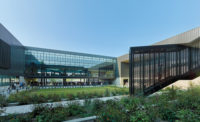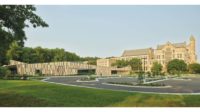You may wonder why an elegant version of an industrial shed would be appropriate for a new Innovation Lab at a private elementary day school—it seems to be a down-home kind of architectural expression for an affluent section of North Dallas. But the Lamplighter School’s history goes far in explaining how the design for the new lab came to be developed by Marlon Blackwell Architects (MBA), of Fayetteville, Arkansas, a firm known for being attuned to regional forms and materials.
Additional Content:
Jump to credits & specifications
The Lamplighter School is a co-ed pre–K-through-fourth-grade institution that prides itself on a progressive curriculum: its goal is to ignite young imaginations through a mix of studies, many emphasizing a do-it-ourselves collaborative approach. Founded in 1953 in a farmhouse, the school had its own campus by 1968—designed by O’Neil Ford, venerated as the leading Texas modernist of the mid-20th century. Ford’s cluster of loosely connected buildings, one to two stories high, made of heavy timber and EIFS, have low-slung roofs that help it hunker down into the pastoral site. In the 1980s and ’90s, Frank Welch, an architect of similar mind but a younger generation—who once worked for Ford—added an octagonal library (now called a media center and fine-arts building), and a gym using light-colored brick with copper roofs.
As Blackwell says about his own low-key approach, “I couldn’t design an O’Neil Ford or Frank Welsh building, but I could give them the best from our office.” He interested the Lamplighter leaders not only because his portfolio included elementary and secondary schools, but because “Blackwell wanted to hear what the faculty needed,” says Joan Buchanan Hill, the head of the school.
The 455 students learn traditional subjects, including languages and fine arts, all of which are taught in the older buildings, while MBA’s scheme for the Innovation Lab accommodates environmental and computer sciences and robotics. In addition, such throwbacks as woodworking and cooking have a place (although the latter involves growing such food items as hydroponic lettuce, and neither is gender-specific). One unusual pedagogical project combines agriculture and business: the young students raise chickens to sell their eggs. According to a business plan, they gather the eggs, track inventory, and market sales through their corporation, Lamplighter Layers, headed by the fourth graders. Profits amassed by the tyro entrepreneurs go to charities.
In addressing the client’s overall programmatic needs, MBA first generated a master plan, working with landscape designers TalleyAssociates. The team moved the ring road for the 13-acre campus so that it no longer runs through areas used by the children. The new circulation allows safer access to the landscape and to a creek, while containing within its boundaries the Innovation Lab and a new Red Barn—where the chicken coop is located. (Additional sheds offer homes to a goat, pig, and cow, so the chickens are part of a larger barnyard family.)
The angular 10,600-square-foot Innovation Lab stands out in this assorted grouping. Its plan is based on two overlapping rectangles, slightly bent where they are intersected by a third triangular piece. Because of the polyhedral shapes, the steel frame’s joists, columns, and beams were challenging. Project architect Bradford Payne of MBA says, “If you change one piece of this triangulation, it affects the structure of the rest.”
The architects chose to enclose the thrusting oblong forms in copper that naturally patinates to a light purplish brown. They worked in close collaboration with fabricators and suppliers to create, in addition to a standing seam roof, exterior walls composed of vertical panels with no horizontal joints. As a result, the copper siding reads more as a unified surface rather than individual panels—“a custom detail that helps elevate the material,” says Payne.
The flinty character of the brownish copper exterior is counteracted by the ruddy tan of local-cypress planks lining the walls and soffits of east, west, and south porches. Cypress extends inside to all ceiling surfaces, where the sloping roofs dramatize a sense of compression and release of space. A softly undulating slatted poplar wall along the southern edge of the 165-foot-long hall provides an area for displays. Walking down this path from the east entrance toward the west, you see different teaching areas unfold throughout these cranked geometries, whose spatial configuration still allows each to retain its own identity. Natural light permeates the interior through skylights and expanses of glass walls that give ample visual contact to the outdoors. The porches on the south, west, and east further encourage outdoor gatherings protected from the sun.
MBA’s replacement of the old barn borrows from its predecessor, with a twist: the roof profile is a play on a partial gambrel shape and is painted red outside, with the exposed wood framing painted white on the interior. Here you find a spacious teaching/conference area, with the chicken coop at the west end, cantilevered above the ground to keep chickens (and their eggs) away from snakes and rodents.
This winter, MBA begins a second phase of work for the school—renovating some of the O’Neil Ford buildings, and adding a new administration building near a porte cochère that the firm installed at the existing main entrance.
With these various interventions and new structures, especially the Innovation Lab as a signature addition, the architects have advanced the forward-thinking goals of the school. As Blackwell says, his firm “was not trying to follow a typological solution for the Innovation Lab. We wanted this educational facility to be a soulful act—to inspire and create wonder. It’s not just a shed.”
CreditsArchitect of Record: Malron Blackwell Architects 42 East Center Street Fayetteville, AR 72701
Personnel in architect's firm who should receive special credit: Marlon Blackwell, FAIA Meryati Blackwell, AIA, ASID, LEED AP BD+C Bradford Payne, AIA Spencer Curtis, Assoc. AIA Stephen Reyenga, Assoc. AIA Cydney Jaggers, Assoc. AIA Stephen Kesel, AIA Kertis Weatherby, AIA, LEED AP BD+C Jonathan Boelkins, AIA
Engineers Mechanical, Electical, Plumbing: Reed, Wells, Benson and Company 12001 N. Central Expressway, Suite 1100 Dallas, Texas 75243 972.788.4222
Structural: Raymond L. Goodson Jr. Inc 5445 La Sierra, Suite 300 LB17 Dallas, Texas 75231 214.739.8100
Civil: Raymond L. Goodson Jr. Inc 5445 La Sierra, Suite 300 LB17 Dallas, Texas 75231 214.739.8100
Consultants Landscape Design: Talley Associates, Inc. 1925 San Jacinto, Suite 400 Dallas, Texas 75201 214.871.7900
Lighting Design: Essential Light Design Studio, LLC 4104 Sperry Street Dallas, TX 75214 972.415.8655
Accessibility: Access by Design Inc. 214.348.7758
Code: SSTL Codes 519 Interstate 30 #629 Rockwall, TX 75087 972.771.8878
General contractor: Hill & Wilkinson
Photographer: Timothy Hursley 1911 West Markham Little Rock, Arkansas 72205 p. 501.372.0640 e. tharkoff@sbcglobal.net |
SpecificationsExterior Cladding Metal panels: site formed 16 oz copper wall & fascia panel Metal/glass curtain wall: Tubelite series 14000 Wood: 4” tongue & groove cypress Moisture barrier: VaproShield breathable membrane Curtain wall: Tubelite series 200
Roofing Metal: site formed 16 oz copper standing seam roof system, 16” exposure
Glazing Glass: Viracon VNE24-63 Skylights: Bristolite skypro series with Solarban 60 tempered glass
Doors Entrances: Tubelite narrow stile aluminum storefront doors Wood doors: Cypress laminated solid core wood door All Glass doors: ¾” clear tempered glass Special doors: Plastic laminate veneered solid core wood door
Hardware Locksets: Corbin Russwin & Adams Rite Closers: Corbin Russwin Exit devices: Rockwood Pulls: Rockwood Security devices: Securitron Other special hardware: McKinney hinges
Interior Finishes Suspension grid: USG suspension system with 4” cypress plank Cabinetwork and custom woodwork: Formica colorcore & Nevamar textured plastic laminated cabinets with corian solid surface tops Paints and stains: Sherwin Williams Epoxy Interior Paint, Benjamin Moore Arborcoat Sealer for wood soffits and ceilings Plastic laminate: Formica & Nevamar Solid surfacing: Corian Floor and wall tile: American olean wall tile – urban canvas Carpet: Interface Harmonize Concrete flooring: Polished concrete Special interior finishes unique to this project: 4” undulating poplar wall planks
Furnishings Chairs: VS America Tables: VS America Other furniture: Palisade designed by Landscape Form
Lighting Downlights: Fluxwerx Pendenant, Lucifer Lighting recessed led downlight, Finelite high performance wall led, Betacalco ring led pendant Exterior: Lumenfacade inground lights, hossley inground lights Dimming system or other lighting controls: Audacy gateway controls
Conveyance Accessibility provisions: TAS compliant
Plumbing [putting each product on a separate line, enter in this way: "Product: Manufacturer Name"] Elkay double bowl sink Symmons kitchen faucet ISE garbage disposal American standard studio carre restroom sink Sloan optima faucet ProFlo trap covers Toto water closet Sloan flush valve Toto urinal Watts urinal carrier Elkay barrier free hung water cooler IPS corp metal ice maker box KitchenAid dishwasher KitchenAid automatic ice maker KitchenAid double wall oven with even-heat true convection KitchenAid French door refrigerator KitchenAid electric induction cooktop
Energy Energy management or building automation system: Chilled water system with central plant and VAV units. Other unique products that contribute to sustainability: Locally sourced materials, local labor force, and sustainable construction methods |
















Post a comment to this article
Report Abusive Comment